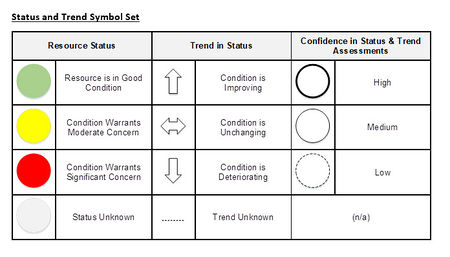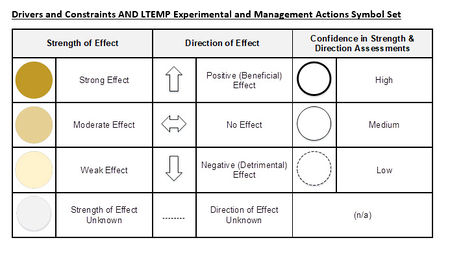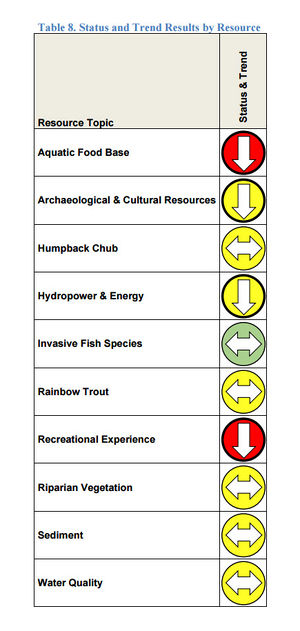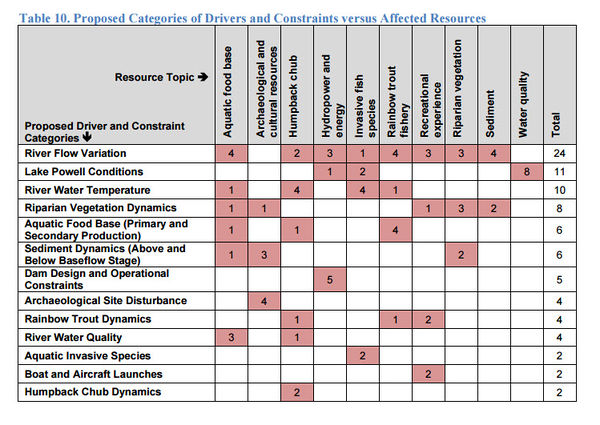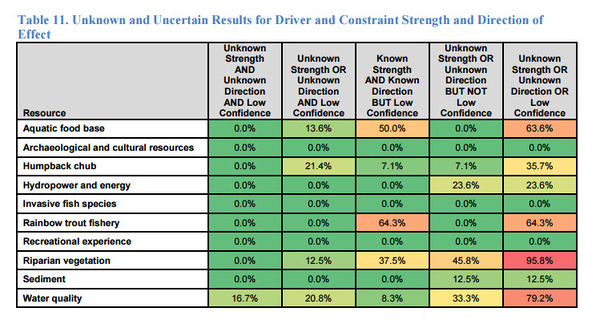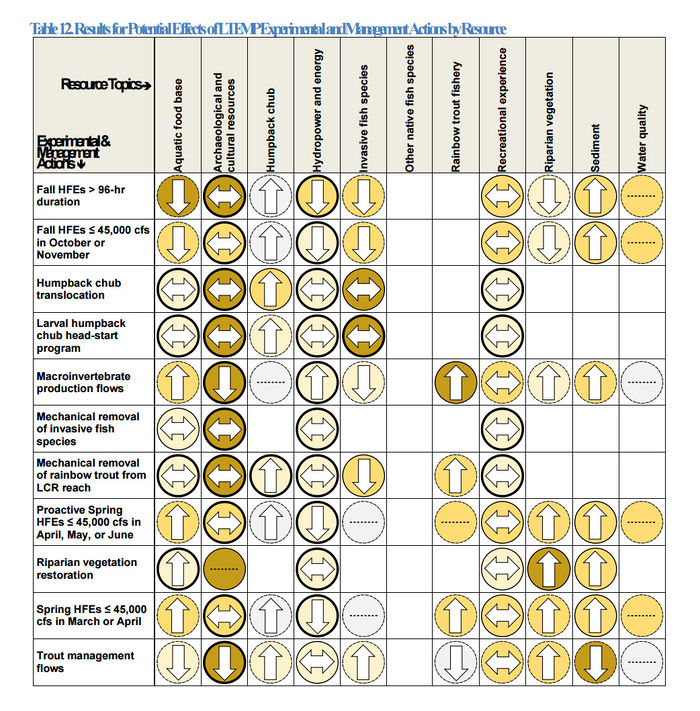Difference between revisions of "2017 Knowledge Assessment"
Cellsworth (Talk | contribs) |
Cellsworth (Talk | contribs) |
||
| Line 81: | Line 81: | ||
*[http://gcdamp.com/index.php?title=The_Bugflow_Experiment Macroinvertebrate production flows] | *[http://gcdamp.com/index.php?title=The_Bugflow_Experiment Macroinvertebrate production flows] | ||
*[http://gcdamp.com/index.php?title=Green_Sunfish_Page Mechanical removal of invasive fish species] | *[http://gcdamp.com/index.php?title=Green_Sunfish_Page Mechanical removal of invasive fish species] | ||
| − | *[http://gcdamp.com/index.php?title=Trout_Reduction_Efforts Mechanical removal of rainbow trout from the Little Colorado River | + | *[http://gcdamp.com/index.php?title=Trout_Reduction_Efforts Mechanical removal of rainbow trout from the Little Colorado River (LCR) reach] |
*[http://gcdamp.com/index.php?title=The_HFE_Page Proactive Spring HFEs ≤ 45,000 cfs in April, May, or June] | *[http://gcdamp.com/index.php?title=The_HFE_Page Proactive Spring HFEs ≤ 45,000 cfs in April, May, or June] | ||
*[http://gcdamp.com/index.php?title=Riparian_Vegetation Riparian vegetation restoration] | *[http://gcdamp.com/index.php?title=Riparian_Vegetation Riparian vegetation restoration] | ||
| Line 98: | Line 98: | ||
=='''Status and Trends''' == | =='''Status and Trends''' == | ||
The experts for the other ten resources assessed the current status of seven overall as | The experts for the other ten resources assessed the current status of seven overall as | ||
| − | meeting the criteria for “Moderate Concern,” and assessed two, aquatic food base and | + | meeting the criteria for “Moderate Concern,” and assessed two, [http://gcdamp.com/index.php?title=FOOD_BASE '''aquatic food base] and [http://gcdamp.com/index.php?title=RECREATION recreational experience]''', as meeting the criteria for “Significant Concern” overall. Only one resource, [http://gcdamp.com/index.php?title=Nonnative_Invasive_Aquatic_Species '''invasive fish species''' (nonnative invasive species)], received an overall rating of “Good Condition.” Since this last resource topic focuses on a threat, its status indicates that, nonnatives, |
| − | recreational experience, as meeting the criteria for “Significant Concern” overall. Only one | + | [http://gcdamp.com/index.php?title=Nonnative_Invasive_Aquatic_Species invasive fish species] overall currently pose only a limited threat to other species in the |
| − | resource, invasive fish species (nonnative invasive species), received an overall rating of “Good | + | |
| − | Condition.” Since this last resource topic focuses on a threat, its status indicates that, nonnatives, | + | |
| − | invasive fish species overall currently pose only a limited threat to other species in the | + | |
system. However, the expert teams consider six of the ten assessed resources currently to be | system. However, the expert teams consider six of the ten assessed resources currently to be | ||
| − | experiencing either no net trend in status, and four – aquatic food base, archaeological and | + | experiencing either no net trend in status, and four – '''[http://gcdamp.com/index.php?title=FOOD_BASE aquatic food base], [http://gcdamp.com/index.php?title=CULTURAL archaeological and cultural resources], [http://gcdamp.com/index.php?title=HYDROPOWER hydropower and energy], and the [http://gcdamp.com/index.php?title=RECREATION recreational experience]''' – to be experiencing |
| − | cultural resources, hydropower and energy, and the recreational experience – to be experiencing | + | |
deteriorating trends in status. The experts did not identify any resource as currently experiencing | deteriorating trends in status. The experts did not identify any resource as currently experiencing | ||
a net improving trend in status. Tables outlining status and trends for each resource characteristic can be found [[Media:GCDAMP FY 2017 Knowledge Assessment Status & Trend Summary Results Final 2017-04-24.pdf | '''here''']]. | a net improving trend in status. Tables outlining status and trends for each resource characteristic can be found [[Media:GCDAMP FY 2017 Knowledge Assessment Status & Trend Summary Results Final 2017-04-24.pdf | '''here''']]. | ||
| Line 114: | Line 110: | ||
The assessment of drivers and constraints identified numerous factors that influence the status of | The assessment of drivers and constraints identified numerous factors that influence the status of | ||
the ten assessed focal resources. These factors fall into thirteen proposed overarching categories: | the ten assessed focal resources. These factors fall into thirteen proposed overarching categories: | ||
| − | aquatic food base dynamics (primary and secondary production), aquatic invasive species, | + | '''[http://gcdamp.com/index.php?title=FOOD_BASE aquatic food base dynamics (primary and secondary production)], [http://gcdamp.com/index.php?title=Nonnative_Invasive_Aquatic_Species aquatic invasive species], [http://gcdamp.com/index.php?title=CULTURAL archaeological site disturbance], [http://gcdamp.com/index.php?title=RECREATION boat and aircraft launches], [http://gcdamp.com/index.php?title=GCDAMP_Glen_Canyon_Dam dam design and operational constraints], [http://gcdamp.com/index.php?title=Humpback_Chub_Page humpback chub dynamics], Lake Powell conditions, [http://gcdamp.com/index.php?title=FISHERY rainbow trout dynamics], [http://gcdamp.com/index.php?title=Riparian_Vegetation riparian vegetation dynamics], [http://gcdamp.com/index.php?title=GCDAMP_Glen_Canyon_Dam river flow variation], river water quality, [http://gcdamp.com/index.php?title=TEMPERATURE river water temperature], and [http://gcdamp.com/index.php?title=GCDAMP_Sediment sediment dynamics (above and below baseflow stage)].''' |
| − | archaeological site disturbance, boat and aircraft launches, dam design and operational | + | |
| − | constraints, humpback chub dynamics, Lake Powell conditions, rainbow trout dynamics, riparian | + | |
| − | vegetation dynamics, river flow variation, river water quality, river water temperature, and | + | |
| − | sediment dynamics (above and below baseflow stage). | + | |
Unfortunately, there is no | Unfortunately, there is no | ||
| Line 158: | Line 150: | ||
experimental and management actions for the ten assessed resources also identified numerous | experimental and management actions for the ten assessed resources also identified numerous | ||
gaps and areas of uncertainty in critical knowledge. The resources with the highest frequencies | gaps and areas of uncertainty in critical knowledge. The resources with the highest frequencies | ||
| − | of such gaps and uncertainties were (in descending order of frequency): water quality, riparian | + | of such gaps and uncertainties were (in descending order of frequency): '''[http://gcdamp.com/index.php?title=WATER_QUALITY water quality], [http://gcdamp.com/index.php?title=Riparian_Vegetation riparian vegetation], [http://gcdamp.com/index.php?title=FISHERY the rainbow trout fishery], [http://gcdamp.com/index.php?title=FOOD_BASE the aquatic food base], [http://gcdamp.com/index.php?title=Humpback_Chub_Page humpback chub], [http://gcdamp.com/index.php?title=Nonnative_Invasive_Aquatic_Species invasive fish species], and [http://gcdamp.com/index.php?title=GCDAMP_Sediment sediment].''' The raw spreadsheet entries indicate that the expert teams reported these gaps and uncertainties because of difficulties with unclear or undefined management objectives |
| − | vegetation, the rainbow trout fishery, the aquatic food base, humpback chub, invasive fish | + | |
| − | species, and sediment. The raw spreadsheet entries indicate that the expert teams reported these | + | |
| − | gaps and uncertainties because of difficulties with unclear or undefined management objectives | + | |
for individual resource characteristics; temporal or spatial gaps in the available data; insufficient | for individual resource characteristics; temporal or spatial gaps in the available data; insufficient | ||
numbers of suitable data points; or high temporal or spatial variability in the available data. | numbers of suitable data points; or high temporal or spatial variability in the available data. | ||
| Line 238: | Line 227: | ||
|style="color:#000;"| | |style="color:#000;"| | ||
| − | + | ==What to Assess and When== | |
*Establish a regular schedule of knowledge assessments, integrated with the development of at least the triennial work plans and the cumulative findings of the Annual Reporting cycle. | *Establish a regular schedule of knowledge assessments, integrated with the development of at least the triennial work plans and the cumulative findings of the Annual Reporting cycle. | ||
*The TWG and GCMRC need not repeat the assessment of knowledge about the potential effects of the LTEMP experimental and management actions. | *The TWG and GCMRC need not repeat the assessment of knowledge about the potential effects of the LTEMP experimental and management actions. | ||
| Line 246: | Line 235: | ||
*The LTEMP and its ROD limit the “Nonnative Invasive Species” resource topic to invasive aquatic organisms, but do not limit it to fishes. The TWG and GCMRC should consider expanding the assessment of this topic to include other aquatic invasive species if ecologically appropriate. | *The LTEMP and its ROD limit the “Nonnative Invasive Species” resource topic to invasive aquatic organisms, but do not limit it to fishes. The TWG and GCMRC should consider expanding the assessment of this topic to include other aquatic invasive species if ecologically appropriate. | ||
| − | + | ==Assessment Structure and Process== | |
*The TWG should make clear from the outset precisely what objectives the expert teams should to use for each resource topic, against which to assess status and trend. | *The TWG should make clear from the outset precisely what objectives the expert teams should to use for each resource topic, against which to assess status and trend. | ||
*The process and its guidance need to be improved to encourage the expert teams to address a smaller number of truly “key” resource characteristics for each focal resource. | *The process and its guidance need to be improved to encourage the expert teams to address a smaller number of truly “key” resource characteristics for each focal resource. | ||
| Line 257: | Line 246: | ||
*The TWG has proposed, and Reclamation and the SAP-EC have requested in the draft FY 2018-2020 Triennial Work Plan and Budget, that the GCDAMP re-establish a “Standing Panel” as part of the SAP, to provide routine review services to the GCDAMP. | *The TWG has proposed, and Reclamation and the SAP-EC have requested in the draft FY 2018-2020 Triennial Work Plan and Budget, that the GCDAMP re-establish a “Standing Panel” as part of the SAP, to provide routine review services to the GCDAMP. | ||
| − | + | ==Spreadsheet Tool== | |
*The FY 2017 KA expert teams – or at least the team leaders – should be polled for feedback on the spreadsheet tool, on ways in which the tool or its associated guidance might be improved. | *The FY 2017 KA expert teams – or at least the team leaders – should be polled for feedback on the spreadsheet tool, on ways in which the tool or its associated guidance might be improved. | ||
*The spreadsheet should include places where the expert teams can or record or find several additional pieces of information, including: | *The spreadsheet should include places where the expert teams can or record or find several additional pieces of information, including: | ||
Revision as of 14:47, 3 May 2017
|
|
2017 Knowledge Assessment (KA)The FY 2017 KA had three objectives:
The resulting information provides crucial guidance for work planning and budgeting. The TWG also conceived the FY 2017 KA as a trial with two additional objectives:
The present (FY 2017) knowledge assessment is timed to coincide with and inform the Annual Reporting process and development of the next GCDAMP Triennial Work Plan for FY 2018-2020. This knowledge assessment is testing a methodology for better organizing, displaying, and communicating its findings, potentially to carry forward to guide future knowledge assessments as well. [1] |
| -- |
-- |
-- |
|---|
The FY 2017 KA addressed three broad spheres of knowledge for each of these eleven focal resource topics:
More specifically, the FY 2017 KA posed three sets of core questions for each of the eleven focal resource topics:
Drivers and Constraints
Effects of Experimental and Management Actions
The last of these three sets of questions focused on eleven specific experimental management actions identified in the LTEMP FEIS and ROD as features of the Preferred Alternative:
The Preferred Alternative in the LTEMP FEIS and ROD also includes summer low flow experiments. However, these will not be attempted until during the second 10 years of implementation of the LTEMP. The FY 2017 Knowledge Assessment focused on topics that might bear on the GCDAMP Triennial Work Plan for FY 2018-2020 and therefore did not address the potential effects of summer low-flow experiments. Through its answers to the three sets of core questions presented above, the FY 2017 Knowledge Assessment sought to:
Status and TrendsThe experts for the other ten resources assessed the current status of seven overall as meeting the criteria for “Moderate Concern,” and assessed two, aquatic food base and recreational experience, as meeting the criteria for “Significant Concern” overall. Only one resource, invasive fish species (nonnative invasive species), received an overall rating of “Good Condition.” Since this last resource topic focuses on a threat, its status indicates that, nonnatives, invasive fish species overall currently pose only a limited threat to other species in the system. However, the expert teams consider six of the ten assessed resources currently to be experiencing either no net trend in status, and four – aquatic food base, archaeological and cultural resources, hydropower and energy, and the recreational experience – to be experiencing deteriorating trends in status. The experts did not identify any resource as currently experiencing a net improving trend in status. Tables outlining status and trends for each resource characteristic can be found here. Drivers and ConstraintsThe assessment of drivers and constraints identified numerous factors that influence the status of the ten assessed focal resources. These factors fall into thirteen proposed overarching categories: aquatic food base dynamics (primary and secondary production), aquatic invasive species, archaeological site disturbance, boat and aircraft launches, dam design and operational constraints, humpback chub dynamics, Lake Powell conditions, rainbow trout dynamics, riparian vegetation dynamics, river flow variation, river water quality, river water temperature, and sediment dynamics (above and below baseflow stage). Unfortunately, there is no simple way to summarize these results. As explained earlier (see Roll-Up Method, above), it is not meaningful to average the rating values for the drivers and constraints affecting an entire resource topic across all associated resource characteristics. In addition, each expert team independently developed its own list of drivers and constraints. This produced a total of 88 different driver and constraint names, with no two expert teams using the same names for any drivers and constraints. As a result, it is not possible to directly compare the ratings for individual drivers across resource topics. However, it is possible to organize the 88 drivers and constraints into a smaller number of categories. Table 10 identifies 13 categories or types of drivers and constraints, incorporating all 88 original “raw” types identified by the ten expert teams (see Appendix C). Other groupings are possible (see Recommendations, below). Table 10 also shows the numbers of individual drivers and constraints in each category, both overall and for each affected resource. Table 10 lists the proposed driver/constraint categories in order based on their overall frequency of identification across all resource topics. Effects of LTEMP Experimental and Management ActionsThe results in Table 12 indicate that the expert teams expect the net effects of the various LTEMP experimental and management actions (across all resource characteristics for the ten resources) to be a “mixed bag.” Each action is expected to have a mixture of net positive to negative and net strong to weak effects on each of the ten resources, on average across all the individual resource characteristics for each resource. No single action is expected to consistently provide a net benefit to all resources. Similarly, with the exception of recreational experience, no single resource is expected to be affected consistently by all actions. In the case of recreational experience, the results indicate that the expert team expects the net effects of all actions on all resource characteristics to be neutral (neither positive nor negative). However, the tables in Appendix D show that these average effects mask a range of variation in effects across individual resource characteristics. The assessments of status and trend, drivers and constraints, and the potential effects of LTEMP experimental and management actions for the ten assessed resources also identified numerous gaps and areas of uncertainty in critical knowledge. The resources with the highest frequencies of such gaps and uncertainties were (in descending order of frequency): water quality, riparian vegetation, the rainbow trout fishery, the aquatic food base, humpback chub, invasive fish species, and sediment. The raw spreadsheet entries indicate that the expert teams reported these gaps and uncertainties because of difficulties with unclear or undefined management objectives for individual resource characteristics; temporal or spatial gaps in the available data; insufficient numbers of suitable data points; or high temporal or spatial variability in the available data. These findings highlight topics that could benefit from improved management objectives, continuing and/or improved monitoring, and/or research to address critical gaps and uncertainties. The concluding recommendations identify needs and opportunities for the TWG and GCMRC to improve the assessment methods and their implementation under five headings: What to assess and when, assessment structure and process, the spreadsheet tool, the scorecard display system, and the default method used to average together the findings across multiple lines of evidence for each resource topic.
|
|
